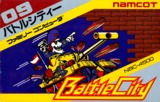Battle City was caught in the rush to port arcade games over to the once-wildly popular (and profitable) Nintendo machines that started off Nintendo's fortunes. While the NES version was a pretty good facsimile of its arcade version – both good and bad things about the latter were retained – the GameBoy version could have been little more than a bad decision on Namco's part.
Like the NES version of the game, the GameBoy one has the player taking control of a tank that has to defeat incoming waves of opposing tanks; as in the other versions of the game, the word "opposing" loosely describes them, because they generally mill about aimlessly and fire off shots in a random manner. There is also the base, which the player must defend from enemies who otherwise have no idea that they can force a game-over by shooting away at it.
In the GameBoy version, differentiating between the player's tank and those of enemies may seem a bit more difficult due to the very limited colour palette of the game. However, Namco appears to realize this and has implemented very different-looking sprites for the player character (they even look different from those in the arcade and NES versions).
(One would wonder that this would not have done much for differentiating between different player characters in co-op mode, but there isn't such a mode in this game, so this would somewhat be a moot point.)
A limited colour palette is not the biggest drawback that the GameBoy inflicts on this game; the small screen of the GameBoy is the worst. Yet, Namco might have gone about this drawback in the wrong way. Instead of shrinking down levels so that they can fit into the GameBoy screen, Namco only shrunk them down partway; the player can only see a portion of it, with the camera centered on the player character.
Considering that the gameplay of Battle City requires that the player keep tabs on the whereabouts of enemies (as erratic and aimless as they are) at all times, a limited view of the level does not help; the player cannot see incoming enemy shots either.
Namco appears to somewhat realize this issue, but its solution leaves much to be desired. A radar has been implemented at the bottom of the screen, but it only shows the locations of enemies relative to the boundaries of the level. It does not show the locations of terrain and obstacles, the locations of the player character and the base, the locations of power-ups that appear in the level and, most importantly, any shots that the player character and enemies have fired. This would not help the player respond to urgent threats, namely those to the base.
Namco appears to somewhat realize this too, and responded by designing the player character such that it is much faster than those in other versions of the game, faster than even the fast tanks that the enemy forces have. Nonetheless, this still does too little to abate the problems mentioned earlier; higher speed does not make up for reduced sight.
Level designs nominally stayed the same (which by themselves would have been a bit of a disappointment to those expecting different levels), leading to the same problems that players would have faced in the NES and arcade versions, only with a partial view of the level and a lousy radar. There may be some consolation to be had from the better-looking sprites that make up these, but it would not please a discerning player.
It has to be noted here too that there is a slight change in how the game handles the destruction of walls. In the other versions of the game, a shot that hits in between two cells of wall destroys both. In the GameBoy version, any shot destroys only one cell at a time. For better or worse, this makes blasting through terrain a bit harder for both enemies and player characters, though the latter do somewhat benefit more from having an actual sense of direction.
The GameBoy version does not have a Construction mode, which can be a bit disappointing (though understandable, as the GameBoy did not have an external memory accessory at the time). However, it does attempt to make use of the machine-to-machine link that the GameBoy has with "Versus" mode, which places both players in the same level and one has to eliminate the other and vice versa. However, they still have to deal with the problems mentioned above. (There may be some suspense from not being able to see incoming shot, however.)
Perhaps the most convincing improvement that the GameBoy version has over the NES version is an improvement in the sound department. The beeps, bloops, warbling and garbling are a lot less pronounced in the GameBoy version, and the GameBoy's audio capabilities do make for a better musical flourish at the start of each level and the game-over screen. (There are no new soundtracks though.)
In conclusion, Namco did try to adapt Battle City for the GameBoy, though whether the results are due to its best efforts or not is debatable. What is certain though is that the results is a game that is more frustrating to play than the other versions.

